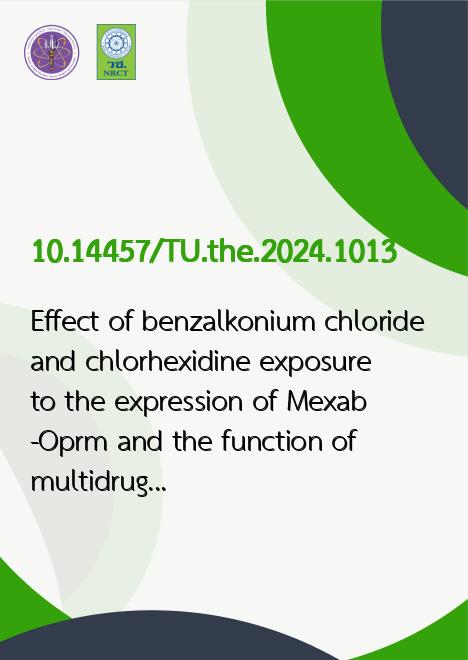
|
Effect of benzalkonium chloride and chlorhexidine exposure to the expression of Mexab-Oprm and the function of multidrug efflux pump of Pseudomonas aeruginosa |
|---|---|
| รหัสดีโอไอ | |
| Title | Effect of benzalkonium chloride and chlorhexidine exposure to the expression of Mexab-Oprm and the function of multidrug efflux pump of Pseudomonas aeruginosa |
| Creator | Thitinan Phutthilertmethawee |
| Contributor | Pholawat Tingpei, Advisor |
| Publisher | Thammasat University |
| Publication Year | 2567 |
| Keyword | Benzalkonium chloride, Chlorhexidine, Multidrug efflux pump, Antibiotic resistance, Pseudomonas aeruginosa |
| Abstract | Pseudomonas aeruginosa is a multidrug-resistant pathogen commonly found in the hospital environment. One strategy for controlling the spread of this pathogenic bacteria in hospitals is the use of biocides (disinfectants and antiseptics). However, ongoing debates continue regarding the possible impact of using biocides including benzalkonium chloride (BKC) and chlorhexidine (CHX) on the emergence of antibiotic resistance. Therefore, the aims of this study are to investigate the impact of BKC and CHX on efflux pump gene expression and activity in various strains of P. aeruginosa and their effects on antibiotic susceptibility.P. aeruginosa PAO1 (ATCC27853), K767 (wild type), K1523 (MexB-deletion), K1455 (MexAB-OprM overexpression) and 15 clinical isolates were tested against BKC and CHX to determine the minimal inhibitory concentration (MIC). Bacteria were then exposed to subinhibitory concentrations (SIC) of the biocides for five consecutive passages. MICs for ciprofloxacin, ceftazidime and gentamicin, as well as the susceptibility status, the transcripts of MexAB and OprM genes and the activity of efflux pump were determined and compared before and after exposure to BKC and to CHX.Most P. aeruginosa strains retained their antibiotic MICs after exposure to BKC and CHX. A few strains had MIC exceeding twice the pre-exposure MICs of the corresponding antibiotics, but these changes were not statistically significant. No changes in antibiotic susceptibility status were observed after exposure to BKC and CHX. Upon exposure to BKC, MexA, MexB, and OprM genes exhibited increased expression in K767, K1455, and clinical isolates (P10 and SP2) though not statistically significant. The MexB deletion strain K1523 showed a significant reduction in MexA expression. Despite some gene upregulation, efflux pump activity remained largely unchanged, except in a clinical isolate P10, which exhibited increased activity. BKC exposure led to an increase in ciprofloxacin, ceftazidime, and gentamicin MICs. However, these changes did not alter the susceptibility status of the isolates. CHX exposure resulted in both decreased and increased efflux pump gene expression and led to variable changes in MICs of ciprofloxacin, ceftazidime, and gentamicin. K1523 showed significant MexA reduction, while K767, K1455, clinical isolates (P10 and SP2) demonstrated increased MexA expression, with K767 exhibiting a more than sevenfold increase. P10 also showed significant upregulation of MexB and OprM. Efflux pump activity remained unchanged in most strains, except for increased activity in P10. The findings highlight the strain-specific response of P. aeruginosa to biocides, impacting gene expression, efflux pump activity, and antibiotic susceptibility. Some P. aeruginosa strains could employ efflux pump to exclude biocides from their cytoplasm. Despite transcriptional changes, efflux pump activity and resistance phenotypes remained largely unaffected. Exposure to SICs of BKC and CHX minimally alters the antibiotic MICs of P. aeruginosa. There was no observed alteration in the susceptibility status to antibiotics. This research provides valuable data for the use of biocides in controlling infections both in healthcare settings and in the general environment, emphasizing the need for understanding biocide effects on bacterial resistance mechanisms. |